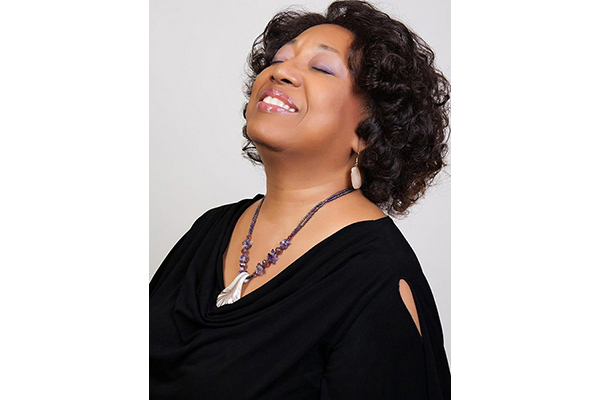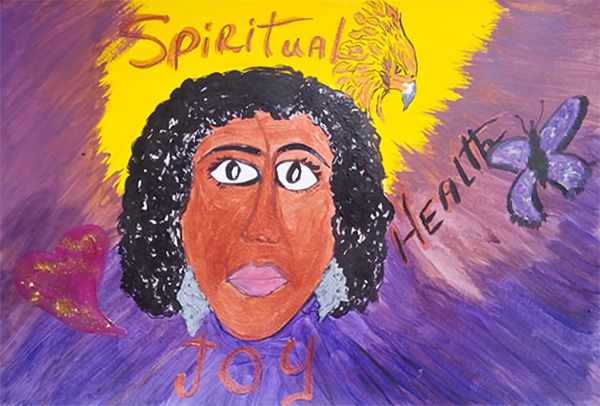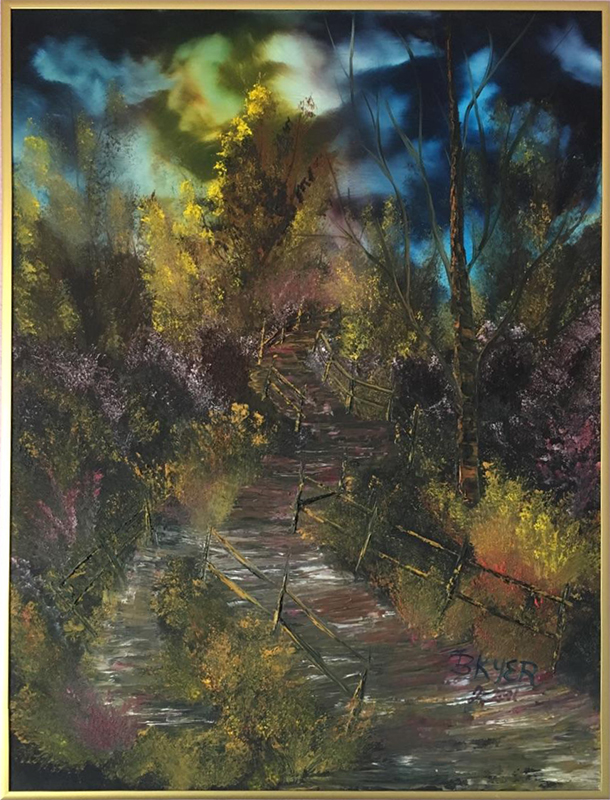Hello and welcome to Fireside Chats with extraordinary people doing amazing things. At the West Coast Child Welfare Trainers Conference I attended this past week, I had the pleasure of meeting many wonderful trainers, including Beverly Kyer, a dynamic and talented speaker. She just wrote the book Surviving Compassion Fatigue: Help for Those Who Help Others. I immediately scooped up a copy and wanted to interview her to find out more. She also participated in the Intentional Creativity session I taught at the conference and I was curious about her experience with the method as a tool for healing.
Beverly has a vast amount of experience in the human services field. She spent over three decades as a clinical social worker working with pediatric oncology patients, Vietnam veterans, psychiatric patients, and foster care. She spent much of her career with the Veteran’s Administration Veteran’s Outreach Center and Medical Center in the Bronx, New York City and the Child Welfare system in California. She has postgraduate certificates and over three decades of experience in integrated approaches to readjustment counseling, post-traumatic stress disorder, and compassion fatigue. She now lectures around the country on compassion fatigue.

What is your profession now?
I am a speaker, educator, author, and clinical social worker. I specialize in secondary and direct trauma impacts of children, youth and adults. Training has been my calling. I like talking to people. I don’t lecture at people. It’s like a conversation and that’s being me, so it’s never felt like a job.
Why did you choose to go into social work?
I was a teacher first in the 60’s. I became very concerned about a mired of circumstances that interfered with children’s capacity to stay connected with the learning process. I learned a lot about their social challenges from their parents. I realized I didn’t have much leverage as a teacher. … I wanted to be able to address the challenges and explore what the issues really were and you can’t do that as a teacher.
As a social worker, I was able to come up with plans with individuals and families to implement change and refer them to the appropriate resources. The wonderful thing about social work is that it addresses every aspect of the human condition — the whole scope. I like having all of that at my hands to implement or direct people to.
When did you discover the impact secondary traumatic stress and compassion fatigue have on human services professionals?
All along I was aware of the changes and struggles of my colleagues. I was able to see shifts and changes in behavior, mood, and attitude. I didn’t understand exactly what it was, other than maybe feeling like someone was being a pain in the behind. [Laughter.] I certainly didn’t realize it in myself. It wasn’t until I suffered heart failure that I sat down and thought, “What the dickens just happened here?” Two hospitals struggled to understand the cause of my heart failure, because my profile didn’t fit anything. We wondered where it came from. As I did research, I realized the breadth and scope of the illnesses that can occur because of unmanaged traumatic stress.
The impact of the work culminated after I worked with groups around the events of 9/11. The protective shield I put over me cracked and I began to have a horrific flood of memories of things I had suppressed over the years — like children I worked with who died of cancer and the ones who had suffered horrendous abuse; The US Veterans whose lives were broken because of the atrocities of war they had experienced. It’s like a dam broke. Those memories almost took me out and overwhelmed me.
What did you do to shift and work through the overwhelm?
I had to get help. Prayer helped me a lot. I stayed in a spiritual place and it came to me to help others so this wouldn’t happen to them. I realized how unhealthy it was to be so focused on my career that I had no life. I had not been in contact with the people I loved. I had no sense of the time I lost and that was pretty awful. I began to change that. I reached out to people, saying I needed to have fun. I told my friends I needed them to reach out and be my accountability partners to live a life. It was hard, but I had to keep getting back to it until I created a healthy lifestyle outside of work.
Why was your motivation for writing this book?
People gravitated towards what I was teaching in the trainings as they were able to connect personally and professionally to my stories, my vignettes, my anecdotes. This motivated many to make healthy changes in how they delivered service and at the same time attended to their own self-care. This propelled me to expand my service. I know I could never reach enough of these heroes so I thought of writing and distributing a book. I wanted to have a greater reach.
What’s the #1 take-away you’d like people to have from reading this book?
It’s not you. It’s not your personal failing. However you may be struggling on the job, for example, if you feel you’ve lost your sense of purpose, it’s not you. It’s the chemical shift as a result of the kind of stress, content, and material you face every day; and that impacts you, cognitively, emotionally, interpersonally, spiritually, behaviorally, physically, etc. It changes you and your world-view. Knowing this information, equips the caregiver such that you not let it overtake your life or take you out of a profession or population you are committed to. The book is to help you look at the problems and what you can do about it to have a quality of life you want.
What drew you to take the “Trainer’s Self-Care Tool Kit” Intentional Creativity workshop I taught at the conference?
That came from more of a personal place, because I had had several losses over the past year. The one that almost shut me down completely, though, was the loss of my son in December. To lose my child was a total, total shock. It almost killed me. I train in grief and loss, and….yet I was afraid if I faced my grief, I wouldn’t be able to hold things together. I over-booked speaking engagements so I was only home a few days a month. Then in the last month, I’d be talking to people and I’d just burst out crying. I was still in that space where I knew I needed to face it… I took the class because I needed to do more work on my wholeness.

Beverly’s painting from the 2016 West Coast Child Welfare Trainer’s Conference
Did the class help with that [your work on wholeness]?
I know it did. It shifted. I thought of the things that made me strong. Like my eagle…to soar like an eagle, instead of feeling like I was against earth’s gravity and kind of stuck to dark parts. I didn’t want to make the image of me abstract, because in my grief I felt abstract. I wanted to make me more solid, whole, and defined. That was like an act of healing, releasing with the determination to be whole again. That’s what the painting was for me. And I realized as I was doing it, I began to get more fixed on what it should be. I was rushing at the end and I almost didn’t stop when you said stop. I was adding things. It was about my completeness, as much as I can be.
You painted a butterfly as well?
Yes. My butterfly was my lightness, my spirit. It had to do with honoring my vulnerability without being scared of it. It’s not a flaw. I don’t operate my life from fear, but I do fear failing. I need to be so strong. The butterfly, said “No. You can be vulnerable. Your spirit person wants to cater to your little girl. Your heart. She’ll still be OK. She’ll still be beautiful and powerful.”
Did you have any insights about your self-care when painting?
…. Your session reminded me to get back into painting. It’s cathartic to me.
Do you feel you can release more through creativity and art?
Yes. We work in darkness. The very reason we have a job is because things are very undesirable in the lives of children and youth and adults. The painting gives me the opportunity to release it and then I get to put light and beauty on top of it.
In my house, I have a painting with dark, dark tall trees in the forest. You can peak through the trees and see light in the future, up ahead with splashes of color in the foliage…beautiful and light. There is a path I painted that is dark initially, with light up ahead. I painted this painting– “Proceed on Faith”– in one of the darkest periods in my life. I was so sad and I deliberately painted it dark. The light happened, accidentally, and then I couldn’t stop myself from the light. I was drawn to it. It shifted and I shifted.

“Proceed on Faith” by Beverly Kyer
Are there other self-care realizations you had as a result of the session?
Painting is on my list of things to do. I’m planning a trip to paint for my birthday after the book signing. I also wrote down to have more fun and to reduce the amount of speaking engagements I do in a week. And that’s all part of it. I’ll also work in my yard, which gets terribly neglected when I’m traveling. I also recruited people to help support me and invited them to meddle in my life! My revelation was that I have been sporadic in these self-care efforts. I chose to be consistently diligent about caring for me.
Any final pearls of wisdom you’d like to share?
We work very hard to help those in great need and a large part of that is a mission. Another part of that mission is a need to work to provide a life. I like to tell people, don’t confuse that with having a life. Don’t confuse having a career with a life. You have to create a lifestyle that has your well-being as a priority.
Thank you, Beverly.
You can meet Beverly at a book signing she is offering to those in the human services field to honor and appreciate the work you are doing. The book signing is on Friday, September 30, 2016 from 6:00 – 9:00 p.m. at the Joyce Gordon Gallery, 406 14th Street in Oakland, CA. Please RSVP at [email protected].
I want to provide a space to share our self-care stories in case any ideas resonate with each other. Prompted by Beverly’s last pearls of wisdom, I ask you this: How do you practice self-care to support your life outside of your career & work?


One of the most significant and meaningful ways I’ve learned to take care of myself in the past couple years, is to work 3 days a week at my school counselor job. and the way I’ve been able to support myself on 3 days a week is by living in a smaller home, driving a cheaper car and riding my bike more. All the things I really need are food and some good school-based health insurance! when I retire in a few years, I will actually be bringing in more money than I do now. By years of needing less, I will be living like a Queen!
Prenny, Thanks so much for posting your self-care wisdom! I love what you are doing to take care of yourself. You inspire me. xoxoxo–Rachel
And I can say the same back atcha, Rachel. Guess we’re a mutual admiration society! Esalen has a way of putting the right people together at the right time.